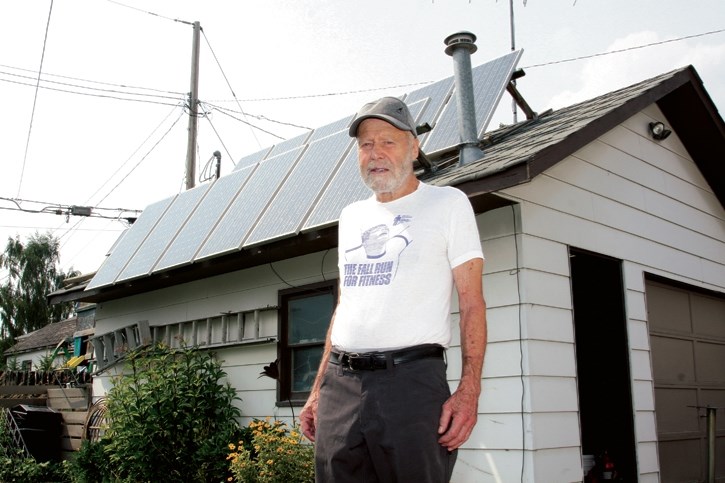Around the globe, the cost per watt of solar power installations continues to fall and that trend has allowed Bill Hamilton to expand his array and boost output for his Exshaw project.
Years ago, Hamilton decided to embrace the idea of energy conservation, in a small way, by switching out incandescent lightbulbs for fluorescent units.
In honour of his sister’s passing some years ago, though, he upped his game by installing a small hydro generator at an off-grid property he owns near Golden. He then branched out by installing a dozen 60-watt solar panels on the roof of his Exshaw garage.
From those relatively humble first steps at producing his own power, Hamilton has expanded his efforts on both of his properties.
Today, the south facing side of his garage roof is nearly covered by a dozen 175-watt panels that has tripled his power output. On a sunny, smoky Monday afternoon (July 31) the panels were producing 1,100 watts, not quite the 1,800 maximum his system is capable of.
Since he began, his Exshaw solar power project has provided 16,500 kilowatts of power.
“I’ve been working on this for almost 10 years now,” said Hamilton, an inveterate tinkerer. “Right now, for four months of the year (summer in Exshaw) it gives me as much power as I use. In January, I get about 10 per cent of the power I get in summer and in fall the mountains get in the way of full sun.
“But we live in the northern hemisphere, so that’s how it is.”
For his original 60-watt panels, Hamilton paid about $500 each; with the new $175-watt panels, the cost was the same. “And if I replaced them again today, they’d cost less again,” he said. “The problem is I still have to pay $35 a month for the wire hookup.”
Hamilton’s solar power goes into the grid via a grid tie inverter, and what he uses beyond his solar, in the evening, for example, he pays for.
Having replaced his first set of solar panels, Hamilton is now upcycling them with a new project where he’s attaching them to an electric water heater which would then push pre-heated water to his natural gas water tank to save on natural gas costs.
Currently, Hamilton’s system is running about as productively as he can get it. To produce 100 per cent of his power, he’d need a system 10 times larger, which would simply be too expensive. Plus, there wouldn’t be enough roof space on his garage and home to accompany the massive array needed.
Meanwhile, on his property near Golden, Hamilton has harnessed hydro, solar and wind to supply juice to his off-grid home. The nearest power pole is eight kilometres away from the property and the cost to run a line to his it would be prohibitive.
Having started with a hydro project that “could turn on a car brakelight,” he’s now producing most of the power needed at the more remote property.
As further examples of his dedication to recycling and upcycling, Hamilton’s steel windmill tower came from a former mine home in Canmore, while the dozen batteries his power is stored in are former communications system batteries which weigh close to 500 pounds apiece and hold about nine gallons of sulphuric acid.
In producing his hydro power, Hamilton runs creekwater through 800 feet of pipe, over 200 feet of elevation drop, to turn a wheel.
All Hamilton’s work, he said, is a tribute to his sister Brenda, who passed away several years ago. “She was an environmentalist and she left me a few dollars. This is a tribute.”




